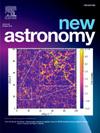亚土星系外行星HAT-P-12b的凌日时间变化
IF 2.1
4区 物理与天体物理
Q2 ASTRONOMY & ASTROPHYSICS
引用次数: 0
摘要
我们展示了HAT-P-12b的凌日时间变化(TTVs),这是一颗低密度的亚土星质量行星,绕着一颗金属贫乏的K4矮星运行。利用14年的观测数据(2009-2022),我们的研究结合了7个新的地面光度过境观测数据、3个过境系外行星测量卫星(TESS)数据和23个先前发表的光曲线。利用线性模型、轨道衰减模型、附侧进动模型和正弦模型等分析了46条光曲线,以研究其他行星的存在。恒星潮汐质量因子(Q -百科~ 28.4)低于理论预测,使得轨道衰变模型不太可能解释。旋进模型的χ 2为4.2,显示了轻微的轨道偏心(e = 0.0013),旋进率为0.0045 rad/epoch。使用广义Lomb-Scargle (GLS)周期图进行频率分析,发现了一个显著的周期信号,频率为0.00415周期/天(FAP = 5.1 × 10 - 6%),表明有额外的行星伴星的影响。正弦模型的卡方减小值最小(χr2)为3.2。时间残差的正弦拟合估计该伴星的质量约为0.02 MJ,假设它与HAT-P-12b处于2:1的平均运动共振(MMR)中。此外,阿普尔盖特机制的振幅比观测到的156 s的TTV振幅小得多,证实了恒星活动不是观测到的变化的原因。本文章由计算机程序翻译,如有差异,请以英文原文为准。
Transit timing variations of the sub-Saturn exoplanet HAT-P-12b
We present Transit Timing Variations (TTVs) of HAT-P-12b, a low-density sub-Saturn mass planet orbiting a metal-poor K4 dwarf star. Using 14 years of observational data (2009–2022), our study incorporates 7 new ground-based photometric transit observations, three sectors of Transiting Exoplanet Survey Satellite (TESS) data, and 23 previously published light curves. A total of 46 light curves were analyzed using various analytical models, such as linear, orbital decay, apsidal precession, and sinusoidal models to investigate the presence of additional planets. The stellar tidal quality factor ( 28.4) is lower than the theoretical predictions, making the orbital decay model an unlikely explanation. The apsidal precession model with a χ of 4.2 revealed a slight orbital eccentricity (e = 0.0013) and a precession rate of 0.0045 rad/epoch. Frequency analysis using the Generalized Lomb–Scargle (GLS) periodogram identified a significant periodic signal at 0.00415 cycles/day (FAP = 5.1 × 10−6 %), suggesting the influence of an additional planetary companion. The sinusoidal model provides the lowest reduced chi-squared value (χ) of 3.2. Sinusoidal fitting of the timing residuals estimated this companion to have a mass of approximately 0.02 , assuming it is in a 2:1 Mean-Motion Resonance (MMR) with HAT-P-12b. Additionally, the Applegate mechanism, with an amplitude much smaller than the observed TTV amplitude of 156 s, confirms that stellar activity is not responsible for the observed variations.
求助全文
通过发布文献求助,成功后即可免费获取论文全文。
去求助
来源期刊

New Astronomy
地学天文-天文与天体物理
CiteScore
4.00
自引率
10.00%
发文量
109
审稿时长
13.6 weeks
期刊介绍:
New Astronomy publishes articles in all fields of astronomy and astrophysics, with a particular focus on computational astronomy: mathematical and astronomy techniques and methodology, simulations, modelling and numerical results and computational techniques in instrumentation.
New Astronomy includes full length research articles and review articles. The journal covers solar, stellar, galactic and extragalactic astronomy and astrophysics. It reports on original research in all wavelength bands, ranging from radio to gamma-ray.
 求助内容:
求助内容: 应助结果提醒方式:
应助结果提醒方式:


